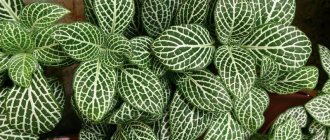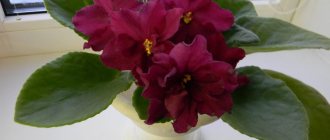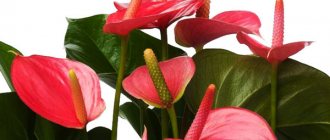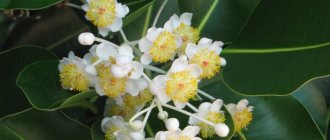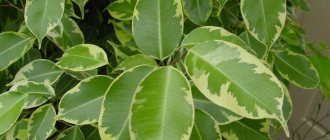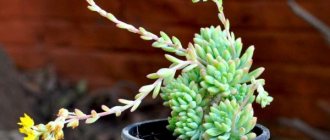Abutilon Juliet or indoor maple is a type of perennial, evergreen shrub, reaching a height of 2 meters. It is easy to care for and has a bright, colorful appearance due to its abundant flowering. The indoor maple got its name due to the similarity of the leaves to maple leaves, which have carved edges and reach 15 cm in length. They have a bright, rich color from light to dark green, emerald shades.
Review: Seeds Aelita “Hybrid Abutilon. Juliet" color mixture – Beauty from a seed
Hi all!
Anyone who has already read my reviews knows that I am passionate about floriculture. And that includes anyone growing indoor plants from seeds. This time I decided to grow a homemade abutilon maple. This is a wonderful unpretentious plant. It grows quickly from seeds and blooms early with the most beautiful colorful bells. By the way, if you have two abutilon seeds of different colors grown from seeds, then you can cross-pollinate them and get homemade abutilon seeds of a completely new color. A most exciting activity, isn’t it!?) I’ll say right away that this is not the first time I’ve planted abutilon. I already grew it from seeds at the dawn of my passion for floriculture. Cute little plants grew and even bloomed. That's when I fell in love with them! But then, for some reason, unfortunately, they died. So, I decided to grow tender homemade maple again. Since I do not have the best attitude towards the Gavrish company (my experience in growing dracaena and lantana from this company Gavrish), when I saw Aelita brand abutilon seeds on sale, I made a choice in their favor. Although, taking into account the good germination of abutilon seeds in themselves, I can assume that Gavrish seeds would also germinate. But this is just a guess. So, I had in my hands a bag of Abutilon hybrid Juliet (a mixture of colors).
The manufacturer promises us early, long-lasting and abundant flowering of the large-flowered hybrid.
On the back of the package, as usual, there is brief information about the plant and planting recommendations.
In total there are 0.1 grams of seeds in the package, which is about 5 pieces.
The manufacturer recommends sowing the seeds in February-March in loose soil, to a depth of 0.5 cm. Before planting, soak until they swell. I did just that, sowed the seeds in loose soil, in a greenhouse and on a bright windowsill. The seeds germinate well, but not well. And in the process of growth, some are ahead of others. So, I got 4 abutilons. Two are larger, the other two are babies, not very strong at the moment. The photo shows one of the large sprouts (to be more precise, medium in size).
I placed them in different cups. I keep it on a bright windowsill and believe in the miraculous influence of spring and the spring sun on the development of flowers. My beauties haven't bloomed yet. But, I hope, until this moment there is very little time left. I’ll try not to forget and add photos of already blooming abutilons to the review. To summarize, I will say that I am quite pleased with these seeds from Aelita, good germination, low price. Anyone who wants a flower miracle on their windowsill, feel free to buy abutilone seeds from this company.
Beautiful window sills and a great mood to everyone!
Abutilon, indoor maple, rope plant - all these are the names of an amazing indoor plant that combines unpretentiousness and long-term abundant flowering. Fast growth and beautiful foliage complement the pleasant impression and make this flower a desirable specimen in many collections.
Abutilon received the name “indoor maple” due to the external resemblance of the leaves to maple leaves.
The flower is called rope flower because in its homeland, fiber is obtained from the stems of certain species, from which ropes and ropes are made.
Under natural conditions it grows in the tropical and subtropical climates of Africa, Asia, America and Australia. Represents the Malvaceae family.
In its natural habitat, the plant species may appear as an herbaceous plant, shrub, or small tree.
In the section you will see a photo of abutilon (indoor maple), as well as its types and varieties (megapotamian, Bella, Juliet, Bellevue, etc.).
Tips for growing abutilone
Caring for abutilone at home does not require much attention or any special skills. You just need to follow some simple recommendations.
Cable car landing
Abutilone from seeds is grown in a mixture of peat, light soil and sand (in a ratio of 2:2:1, respectively).
- It is recommended to sift the soil before sowing so that it becomes loose and retains moisture better. It also needs to be disinfected with potassium permanganate from fungi and bacteria;
- Seed material is soaked in warm water for 12 hours;
- The seeds are planted in a pot at a shallow depth of about 5 mm, covered with film to create a “greenhouse” and placed in a warm, sunny place. Shoots begin to appear after about 20 days;
- When the first leaves appear, you need to plant the seedlings in small cups with a diameter of about 7 cm. Now you just need to properly care for the abutilone, creating the required level of humidity, lighting and temperature (more on this below), and within six months the plant will begin to bloom.
Of course, you can buy an already mature flowering specimen at a flower shop, but the price of seeds is much cheaper, and growing a “green friend” yourself is much more pleasant and interesting. The cost of a package of seeds averages 20 rubles, and a young plant will cost about 500 rubles.
Required temperature and lighting for indoor maple
The home maple abutilon is a flower that needs light too much. A room with plenty of daylight is good for it, but the plant does not like very bright lighting. In the summer, it should be taken out into the fresh air, onto a veranda or balcony, placed in a shaded corner. But the “green pet” may not bloom if there is insufficient light.
In summer, in the room where abutilone is contained, the optimal temperature level should be +20-25 degrees, not lower. In winter, it is permissible to reduce the temperature to +10-15 degrees, but it must be taken into account that if the shrub is kept in a room with a temperature of +10 degrees for a long time, it will begin to dry out.
Watering the ropeway
When the plant begins active growth (during the warm period), it must be watered regularly and abundantly. This process cannot be reduced during flowering of home maple. Excess water that accumulates in the pan about two hours after watering is poured out. Somewhere from November, you need to water the bush less and this rule must be followed until February.
If the soil is subject to drying out or waterlogging, the maple may lose its flowers and dense crown.
Air humidity
The “green resident” loves moisture very much, so if it is in a stuffy room, it needs to be sprayed with water as often as possible. When the bush is flowering, spraying is done very carefully - water should not get on the flowers.
Fertilizing home maple
Abutilon needs feeding with organic and mineral fertilizers regularly once a week. When the bush is actively growing, when it gains green mass, which happens in the spring, it is advisable to add nitrogen. Before flowering, domestic maple is fertilized with potassium and phosphorus, but in winter the fertilizing process is not necessary at all.
Trimming
Abutilon must be pruned in a timely manner so that the bush has the correct size and height, because it has the ability to grow quickly.
Until the “green friend” begins to actively grow, its shoots are cut to 1/3 (or 2/3) of their length. This shortening stimulates lush flowering and forms a beautiful crown. On young shrubs, pinch off the tops, and then the plant is transferred to a warm room, well fed and watered.
Replanting a home maple
This procedure is done annually. The container does not have to be much larger than the previous one. Abutilon begins to bloom when its roots completely envelop the soil. It is best to buy soil for planting in flower shops, because it is already disinfected from parasites and is rich in beneficial properties.
Propagation by cuttings
Reproduction of the shrub occurs by cuttings or seeds. The most favorable time for propagating maple by cuttings is August. Although this can be done at all times of the year.
- We take a cutting up to 12 cm in length with a flexible trunk. We remove the lower leaves and buds from it. To plant cuttings, we use a mixture of sand and peat, or a ready-made substrate from the store.
- We plant the cuttings in small cups and cover them with jars. In this way we create a kind of greenhouse conditions, and after a month the seedlings have a root system. During this period, they need to be watered, sprayed, and ventilated.
- Then we transplant the sprouted cuttings into pots with a diameter of 7 cm, no more.
Reviews from gardeners and florists about abutilone are extremely positive due to its unpretentiousness. Every flora lover can grow such a beauty. It is enough to show attention and care to it, and the indoor maple will give you bright flowers and lush branches of leaves.
Types and varieties
The leaves of indoor maple are large, carved, with three or five lobes. Their color is green, spotted or mottled. Flowers can be single or double, single or bicolor, on long stalks. The colors are very different: white, red, pink, orange, burgundy, gold. The shape of the flowers resembles bells or Chinese lanterns.
About 150 types of abutilone are known . Hybrid varieties bred on the basis of these species are also grown indoors. The most common varieties of indoor maple are:
- Abutilon Juliet is an unpretentious and fast-growing hybrid variety. Has large green leaves and large flowers;
- Abutilon Sello - has leaves on branched, slightly pubescent shoots, flowers with pink veins;
- Abutilon Darwin - has a spectacular appearance: large orange flowers with dark veins and bright green velvety leaves;
Types of abutilone
This shrub has more than 100 varieties and hybrids. Let's look at the most suitable species for home cultivation with photos.
- Abutilon Bella is a recently bred variety, which is distinguished by the presence of voluminous bright flowers of pink or golden color (diameter about 8 cm) and large branching. It grows to about 40 cm and blooms beautifully throughout the year. Does not require pruning or pinching;
- Juliet is a very unpretentious species, the cultivation of which does not require abundant lighting and frequent watering. The plant reaches half a meter in height and produces bright large flowers six months after sowing the seeds;
- Organza is a branched shrub up to a meter in height with smooth green foliage and large bright flowers, arranged singly. Requires frequent pruning to maintain shape;
- Bellevue is a hybrid mixture that has flowers in all the colors of the rainbow. It is a lush, beautiful bush that reaches a height of up to two meters under the right care conditions and constant pruning;
- Bella mix is another hybrid with large flowers (diameter up to 8 cm) in delicate tones: yellow, apricot, pink;
- Sello - this variety is distinguished by light branching and inflorescences of peach tones with pinkish veins. Flowering occurs from July to December;
- Tiger's Eye is a large shrub with orange-hued flowers and red veins. It looks very beautiful and resembles a lantern.
Abutilon hybrid Juliet: botanical characteristics, how to grow
Decorative indoor maple (abutilon) is an evergreen shrub, actively used in the decoration of residential and office premises, greenhouses, and halls. One of its varieties, the Abutilon Juliet variety, is especially popular due to its unpretentiousness, rapid growth and beautiful appearance. It is ideal for indoor growing because it does not require intense lighting and yet blooms profusely all year round.
How to trim abutilon
Abutilone grows very quickly, so it needs to be pruned. In spring, the plant wakes up and in order for the bush to be lush and beautiful, the shoots are cut into 3 parts, but not to the very root. Timely pruning of bushes allows you to form the correct size and height of the tree.
Young plants are pinched at the top, which allows the bush to grow wider and bloom profusely. Abutilon is trimmed according to your expectations. Whatever size shrub you want, trim it.
Abutilon Juliet color mixture: description of the plant
Abutilon Juliet (abutilon Juliet) is a large-flowered hybrid bush plant that grows up to 150 cm in height. It has a high growth rate: the shoots increase annually by about 50 cm. The leaves of this abutilon are large, up to 15 cm in length, with carved edges, in shape similar to maple foliage of rich green color. Hence the second name of the plant - “indoor maple”.
The genus of domestic maple belongs to the malvaceae family. It grows naturally in the tropics and subtropics, where it is warm and humid. There it grows in the form of bushes, small trees or perennial grass and has more than 100 species.
With proper care, the hybrid abutilon Juliet grown from seed blooms at 4 or 5 months of life. With sufficient lighting, flowering occurs all year round. The flowers are bell-shaped, looking down, the diameter of the wide part is about 5-6 cm. The color of flowers in different shrubs can be pink, red, orange, bright yellow. If two shrubs with flowers of different colors have grown, then they can be crossed through cross-pollination and get Juliet with flowers of a new color.
The variety is unpretentious, loves light, but not too intense. With minimal care, even a novice gardener can grow a strong, profusely flowering plant without any problems.
How to trim Abutilon
Sometimes it is a pity to prune a beautiful, densely growing tree, but this action is necessary. It should be taken as a rule and carried out annually at the end of winter. The better the crown is formed, the more magnificent the color will be. Shoots from last year are removed by a third of their length, and the tops of young ones are pinched off.
After trimming, the flower pot is placed in a warm and humid environment. Periodically turn it towards the light and spray it. This process contributes to the formation of an even and compact crown.
Abutilon Juliet: growing from seeds
Growing this abutilone from seeds is convenient because the germination rate of the variety is almost 100 percent. Most often, store-bought seeds of a “mixture of colors” are used for sowing. Sowing is carried out at the end of February or beginning of March.
Pre-sowing soil preparation is required. The soil is sifted to give it a looser and more moisture-absorbing structure, and treated with a solution of potassium permanganate to destroy possible fungal and bacterial infections. The optimal soil for abutilons includes peat, humus, river sand and vermiculite in a ratio of 2:2:1:1.
Abutilon is propagated by seeds and semi-lignified cuttings. Non-variegated forms of abutilon are propagated by seeds, since during seed propagation the parental characteristics are split.
For sowing you need to choose high-quality hybrid Juliet seeds with an intact dark-colored shell. Abutilon seeds with a damaged shell usually do not germinate. Before placing in the soil, the achenes selected from the mixture are soaked for 12 hours in warm water. You can make a growth stimulant solution for soaking.
Seeds of future abutilons are immersed in the soil to a depth of approximately 5 mm. The pot is covered with film and placed in a warm, illuminated place. Shoots should be expected after 3 weeks.
After the first maple leaf appears, the seedlings can be picked. For better growth of the transplanted plant, take a container no larger than 7 cm in diameter. After transplantation, young abutilons are cared for in the usual way: they monitor the sufficiency of lighting, soil moisture, and air temperature. Fertilize the soil once a month.
Shrubs grown from a mixture of seeds are stronger and more resilient than hybrid plants obtained by cuttings or propagation by leaves. It is noteworthy that the color of their flowers is more juicy and rich.
How to propagate Abutilon
The Abutilon shrub can be propagated by cuttings or seeds. These breeding methods are well suited for flowers with green leaves. Many varieties of Abulon are perennial, therefore, it is beneficial to plant the shrub once and enjoy its beautiful flowers.
Shrubs can be propagated by cuttings at any time of the year, but it is advisable to do this when the cuttings have not yet become woody. In March, cuttings with a flexible trunk are cut, flower buds are torn off, and they can be used to grow new plants.
Take cuttings about 12 centimeters long. First you need to prepare a store-bought substrate or sand-peat mixture . From each cutting, the leaves below and the buds of flowers that have not yet had time to bloom are torn off.
It is convenient to plant shoots in small containers (glasses, pots) and cover them with jars. They remain in this state until they take root. The temperature in the room should be about 25 degrees Celsius, such conditions are similar to a greenhouse and the plants will grow faster.
Seedlings should be regularly ventilated, sprayed with settled water and watered. Within a month, a root system should form and the seedlings will sprout. Next, the young animals are transplanted into small pots or glasses; the diameter of the container should not be more than 7 centimeters.
If you want to get healthy plants, you will need to follow all abutilone care technology.
Features of planting and care
It is not difficult to grow abutilon if you follow some simple rules. The bush should be kept indoors where there is enough light, but direct intense sunlight does not fall on the shoots. In warm months, the abutilon bush can be taken out onto the veranda or balcony, placed in a corner where direct sun does not penetrate. If there is insufficient lighting, the plant will not die, but it is unlikely to bloom.
During the summer months, the ideal air temperature in the growing area is between +20 and +25°C. In the cold season, Juliet can easily withstand temperatures from +10 to +15°C. But if Abutilon is forced to remain at a temperature below +10°C for a long time, then the shoots begin to dry out.
In the summer season, during the period of active growth and flowering, regular abundant watering is required. The water that accumulates in the pan is poured out. If the soil is poorly moistened, the shrub may shed its leaves and flowers. If the air is hot and dry, then spraying is necessary. The plant is sprayed carefully, the spray should not get on the flowers. From the end of autumn they switch from heavy watering to moderate watering, which continues until the end of winter.
The bushes are fed with mineral fertilizers and organic matter. Feeding is carried out once a week in the warm season. In the first weeks of spring, the application of nitrogen is preferable, and during the period of active flowering, potassium and phosphorus are recommended. During the winter season, fertilizing is not carried out.
To obtain a beautiful and neat crown from a hybrid abutilon, pruning is carried out periodically. The top of a young plant is plucked off to start the process of branch formation. In an adult Juliet bush, shoots are cut off by 1/3 or 2/3 of their length every year, in early spring. Abutilon grows quickly, and timely pruning not only allows you to form a neat crown, but also makes flowering abundant and the color of the flowers brighter.
From the first year of life, the plant must be replanted annually, each time choosing a larger pot. Flowering begins when the roots fill the entire soil.
Diseases and pests of Abutilon
Abutilone is not considered a capricious plant, and yet, when a gross violation of care technology occurs, problems may arise. A sharp change in room temperature, bright sunlight, lack of normal lighting and draft can cause the bush to shed its leaves.
The same problems can arise if the watering schedule is disrupted or there is no plant nutrition. Insufficient lighting immediately affects the bush; its leaves gradually lose their rich shade and, if nothing is done, they turn yellow and crumble.
The situation is fixable: just move the bush to a bright place and the problems will gradually go away. Accustom the plant to bright light gradually; at first there should always be a slight shadow.
If the tips of the leaves of the bush dry out, this indicates that it does not have enough water, and the air in the room is dry. In this case, Abitulon is sprayed daily from a spray bottle, and an open container of water can be placed nearby so that the air in the room is constantly humid.
When you spray a plant, make sure that the water does not touch the buds. This can cause them to rot and fall off. Abitulon is practically not damaged by pests , but if the care regime is not followed, spider mites, scale insects or aphids may appear. These parasites have long been known, and stores are full of chemicals to combat them.
Abitulon grows well in commercial, private, administrative and educational premises. It will beautifully complement the interior, and it will be easier to breathe in the room where the plant is located. The bush humidifies the air and relieves psychological stress.
It is not difficult to raise such a handsome dog if you give him a little attention and follow the care technology.
Leave a review and get a plus for your site karma:
Reviews of Abutilon Juliet
It is believed that Abutilon relieves nervous tension, improves the mood of household members, calms the soul, awakens inspiration and promotes pleasant communication.
In flower shops, the seeds most often sold are “Abutilon hybrid Juliet mixture of colors” from. Customer reviews of this abutilone are extremely positive. Among the advantages of the variety are high germination rate, rapid growth, resistance to different environmental conditions, and low price. Buyers do not find any shortcomings.
Advantages of seed propagation
Fresh seed material of an ornamental plant has very high germination rates , and respect for planting and growing rights allows you to obtain a large amount of healthy and high-quality seedling material.
Currently, breeders and amateur gardeners have produced many interesting varieties of abutilone, so sowing several varieties in one flower pot allows you to create the most interesting and highly decorative flower arrangement. Properly grown from seeds, abutilons have excellent hardiness and are perfectly adapted to growing conditions.
Hybrid abutilone: growing from seeds, home care
Abutilon may not be one of the most popular ornamental plants, but more and more people are beginning to notice the beauty of this small bush. Undoubtedly, the hybrid cable car will decorate not only the apartment, but also the terrace and garden. Its decorative appearance is due to large, bright flowers, as well as leaves.
Hybrid abutilon (Abutilon x hybridum) belongs to the Malvaceae family. Its natural habitats are found in the forests of South America (Brazil).
The genus Abutilon includes more than 100 species of very diverse plants (shrubs, subshrubs, herbaceous plants), which reach a height of several meters. When growing at home, we mainly encounter hybrid forms of hybrid abutilon (Abutilon x hybridum) and megapotamian abutilon (Abutilon megapotamicum) - with drooping shoots. In our climate they are grown as houseplants.
Indoor maple is characterized by an elevated structure, green shoots, sometimes woody at the base. The bush is fast growing. In their natural habitat, shrubs can reach 3 m in height; home-grown specimens, depending on the variety, can reach a little over a meter in height, and, as a rule, lower. Very decorative leaves, shaped like maple leaves. Depending on the variety, the number of lobes varies - from three to seven. Color ranges from bright green to variegated with white or yellow spots. Numerous bell-shaped flowers appear in spring and bloom until late autumn. Flowers planted on long petioles, depending on the variety, delight with red, orange, white, pink, yellow flowers. The diameter of the flower can reach 8 cm. The seeds are dark and kidney-shaped.
With proper pruning, abutilon can be formed into a small tree.
There are a wide variety of varieties available for sale, so it’s worth looking around and choosing the most suitable variety.
The popular Bella series includes colorful forms with large flowers, up to 7 cm in diameter.
- "Red" with burgundy flowers,
- "Deep Coral" with coral flowers,
- "Apricot Shades" with apricot flowers,
- "Salomon Shades" with salmon-colored flowers.
It is worth noting that these are dwarf forms, approximately 45 cm high.
The following varieties will please you with yellow color: “Canary Bird”, “Golden Fleece”, and “Cannington Carol”, “Cannington Sally” with spotted leaves. The "Ashford Red" variety blooms red. A particularly beautiful variety is “Savitzii” with decorative white-edged leaves.
At the moment, the popular abutilon hybrid Juliet is a mixture of colors , a mixture of varieties of different colors, and the Bellevue variety is a mixture of colors, a shrub 90 cm high, blooms in summer-autumn. Maple green leaves. The flowers are large and of different colors.
Varieties with variegated leaves are the result of infection of abutilon by viruses . The presence of the virus in the cells does not significantly affect the growth of the plant; it may slow down the growth slightly. Indoor maple with spotted leaves looks original.
Plant care
Caring for abutilon bushes is simple, as is growing it, but, like most indoor plants native to the tropics and subtropics, it has its own characteristics. For home breeding, it is better to use hybrid varieties of abutilon: they are more compact and have large buds, and under suitable conditions, they can bloom all year round.
Location and lighting
These flowers love bright light; if there is a lack of it, the number of flowers on the bush decreases. But hot, direct sunlight can burn and deform the leaf plate. It is better to expose the variegated variety only to very weak rays, so as not to damage the crown.
It is better to place the pot with the plant on the windowsills of the western or eastern sides. On southern windowsills, abutilon will need to be protected from the midday sun, especially in summer, and on northern windowsills it will need to be additionally illuminated using special lamps.
Attention! Ropeweed does not tolerate drafts, therefore, if it is placed in a drafty place, the bush will not bloom in the spring, and the blooming one is in danger of the buds falling off.
Humidity and temperature
For good health, abutilone must be kept in suitable temperature conditions. The optimal temperature during the period of active growth and development is 22–25 ᵒC, during the dormant period - not lower than 14 ᵒC.
Requirements
Hybrid abutilone grown at home should be placed in a bright room (south window), this will guarantee lush flowering. Since abutilon can be grown on the balcony and terrace, it is worth using this option, especially since the plant likes fresh air during its lush growth. In the fresh air, it is better to provide a secluded place, sheltered from the scorching sun. Abutilon also grows in partial shade, but in such a place it will not pamper us with too lush flowering.
The room temperature during the growing period is 16-22 °C, in winter it is definitely below 10-15 °C.
The soil is fertile, humus, permeable and rich in nutrients. You can use a universal substrate for potted flowers.
Abutilon care includes watering, fertilizing, replanting, pinching and wintering.
Watering is a very important procedure for caring for abutilone at home, especially during the growth period and when grown in a sunny place. The plant in such conditions needs a lot of moisture. The frequency of watering depends on many factors, but it may turn out that you will have to water the plant daily, when grown outdoors in the ground, during periods of drought, even twice a day. When grown indoors, abutilone should be provided with good drainage because it does not like water. During winter, the soil should not be constantly wet; on the contrary, between the first and second watering the soil should dry out slightly.
During the growing season, abutilon is fertilized every 7-14 days with a multicomponent liquid fertilizer in accordance with the manufacturer's recommendations. In winter they do not fertilize.
The leaves are cleaned by washing off the dust with warm, soft water, being careful not to spray the flowers.
Briefly about care
| Type of agricultural operation for caring for abutilone | Description of conditions and actions |
| Watering and air humidity | Frequent and abundant watering, the soil should always be moist; air humidity does not affect the plant |
| Lighting organization | Diffused light is required, the flower must be covered from hot direct rays |
| Maintaining a rest period | The period is not clearly defined, some varieties can bloom all year round, but rest is needed for proper development and abundant flowering; There are two options for wintering the plant: cold and warm |
| Creating temperature conditions | The optimal temperature during the period of active growth is 22–25 °C; in winter 14-15 °C or 18–22 °C, depending on the selected dormant period |
| Trimming | Annual pruning before the dormant period is required by 1/2 or 1/3 of the crown volume |
| Making soil mixture | You need nutritious and light soil, with neutral or weak acidity |
| Fertilizer application | Fertilizing every 7–10 days with a solution concentration less than that recommended by the manufacturer |
| Transfer | Young plants once a year, adults once every 2-3 years |
| Chemical treatment | Treatment with fungicides in case of fungal diseases and rot, and insecticides in case of pests |
Reproduction
Abutilone hybrid is propagated through shoots and apical cuttings. Basically, seedlings can be obtained throughout the growing season, but it is best to do this in the spring when transplanting and pruning abutilon.
The length of the cuttings is 6-10 cm. The seedlings will take root in a few weeks, provided that humidity is provided (cover with film) and a warm substrate, which is a mixture of peat and sand. Rooted cuttings are placed in a bright place at a temperature of 20 °C. Abutilone is also propagated generatively from seeds. Sowing them in February and May. Purchased seeds germinate fairly quickly (2-3 weeks); those collected by hand are best stratified.
The most common problems when growing
When growing hybrids, you should be careful with numerous pests, which, if there are errors in care at home, often attack weakened plants, especially at low humidity. These include:
- whiteflies;
- spider mites;
- aphid;
- scale insects;
- Mealybugs.
As mentioned earlier, hybrid abutilon loves moisture, but not a wet substrate. When the substrate is too wet, the leaves fall off. The problem very often occurs in winter, when watering should be limited.
Yellowing and falling leaves are a reaction to a significant change in temperature, for example, after moving a plant from the terrace to the house.
In addition, regular watering is required because drought will cause leaves and flowers to curl and fall off .
In a sunny place, with a lack of humidity, plants wither . At noon, it is worth shading the plant and providing it with a sufficient level of humidity.
When growing hybrid varieties, a bright place is very important, which promotes lush flowering. In a dark place the number of flowers is much smaller. In too shaded places the shoots become elongated and the leaves become lighter.
Lighter leaves will be a symptom of a lack of fertilizer . Lack of fertilizer leads to lack of flowering .
Abutilone: types of plants, rules of cultivation and care
Abutilon is an unpretentious indoor plant that will ideally fit into a home or office interior and will decorate winter gardens. It does not require special conditions or careful care, so it is quite popular among flora lovers. You will learn about the types of indoor abutilon and how to grow it correctly in this article.
Description of hybrid abutilone Bellevue
Translated from French, the name of this hybrid means “beautiful view.” It grows quickly and in one season, with good care, can reach its normal height. The crown of abutilon hybrid mixture Bellevue is dense with a large number of leaves and flowers.
It is difficult to guess in advance what color the flowers of the hybrid abutilon mixture Bellevue will be when grown from seeds
The plant develops well with plenty of light and fresh air. Suitable for growing on balconies, verandas, and greenhouses. It grows luxuriantly in the garden, can winter in open ground in the Sochi region, and continues to bloom at +5 °C.
Comment! Abutilon flowers are edible and can be used to feed turtles, birds or snails.
What is abutilone hybrid mixture Bellevue
Multi-colored abutilons are often grown at home from ready-made varietal hybrid mixtures - for example, Bellevue abutilon. Hybrid - because they were obtained by crossing different types of rope. Varietal mix - because they are collected from varieties that do not have an individual name, but have certain common characteristics.
The name of the variety Bellevue (abutilon bellevue) translates as “beautiful view” and is applied to varieties of abutilon that bloom with bell-like flowers with a diameter of more than five centimeters, as well as having a compact main stem shape and small distances between internodes. True, it is impossible to predict which color will prevail in the process of growing seeds from a bag purchased in a store or online. They can be red and pink, yellow and orange, in different proportions but, as a rule, they will be shades of the same color.
Due to the heaviness of the petals, the inflorescence may have a drooping appearance. During flowering, the flowers do not open fully, maintaining a bell-shaped shape. Abutilon Bellevue also has other features: good bushiness and branching - when caring for this plant, it is practically not pinched.
What does abutilone look like?
Among domestic and other flower growers, abutilon (indoor maple) has become widespread as a perennial tree and shrub. This form of indoor maple is distinguished by large leaves, as well as drooping lantern inflorescences, which are decorated with long pedicels.
Already in the first weeks of spring, abutilon pleases with flowers that begin to fade only in late autumn. Among all the variety of abutilon, there are varieties that bloom constantly. They may vary in the color of the leaves, which may be green, mottled or variegated. Peduncles containing long stamens and a pistil also look original: they can be white, orange, pink, red, gold and burgundy. Also, plants can differ in the shape of the flower, on the basis of which simple and double types of abutilone are distinguished.
Psychologists are also familiar with this plant and consider it a unique plant. According to them, growing abutilone is useful for people who often experience depression. First of all, positive changes from his presence will be felt by people whose work takes place in the office and involves stressful situations. Almost every one of us can feel the calming effect, which primarily manifests itself at the flowering stage of abutilone. At the moment, scientists have not been able to understand what causes this, but most experienced gardeners have seen for themselves the effect of abutilone.
Description of abutilone: coloring of leaves, flowers, etc.
Abutilon is popularly nicknamed home maple for its resemblance to street maple. The leaves of these plants are very similar - they resemble splayed fingers. But that's where the similarities end. The plants are not related at all. The indoor maple is a member of the Malvaceae family.
Abutilon is a lover of hot sun and moisture. Its genus includes herbs, shrubs, bushes and even miniature trees. The evergreen plant fits perfectly into the tropical diversity of Hawaiian, South American, Australian and African jungles. In Eurasia, it grows in India, China and Russia. In our country, abutilon is found - the rope of Theophrastus.
Abutilon has taken its place on the windowsills of indoor flora lovers firmly and for a long time. Those who have at least once sheltered this plant always remain faithful to it. There are several reasons for this persistence:
- abutilon is a beautiful lush bush or tree with very decorative, variegated leaves in some varieties;
- the flower grows very quickly and fills the surrounding space with greenery in a matter of weeks. You can grow it as a shrub, tree or hanging plant, whichever you prefer. It is easy to shape;
- Most varieties have amazingly beautiful flowers. And what’s nice is that they begin to bloom immediately after rooting. And the flowering time occurs in spring, summer and early autumn;
- the plant is undemanding to care, easily forgives some mistakes and recovers quickly;
- The flower is very easy to propagate at home. So, by purchasing one pot of abutilone, you can soon become the owner of a whole grove of home maples.
The flowers of the domestic maple are very diverse; sometimes it seems that these are not related plants, but completely alien plants. The inflorescences may resemble a Chinese lantern, a bell, or the familiar mallow. There are varieties with simple and double flowers. Their color can be white, yellow, pink, orange, purple.
Abutilon leaves, reminiscent of maple, are also colored differently. They can be different shades of green, yellow-green, with white spots and stripes.
Botanical scientists have described about 150 varieties of wild abutilone. The most decorative of them gradually became comfortable at home. Based on some, hybrid plants were created for growing indoors. As a rule, these are shrubs or trees that are shorter than in nature, adapt well to living conditions “in captivity”, bloom more abundantly and last longer.
- Abutilone hybrid. A native of America, combining many varieties. This is a bush with a maximum height of one and a half meters. The leaves are large, slightly pubescent with three or five lobes. The slightly fluffy inflorescences are shaped like a bell and are colored in different shades of red, and are also white.
- Abutilon Juliet. The hybrid plant is unpretentious and blooms almost without interruption all year round. Even for a home maple, Juliet grows rapidly, adding 50 cm in height per year. The flowers are of various colors, large, about 6 cm. It begins to bloom very early, five months after sowing the seeds.
- Abutilon Sello. A distinctive feature of the flower is striped leaves with three elongated and pointed blades. The plant branches weakly and stretches to a height of two meters. The flowers are yellow with pink streaks.
- Abutilone Darwin. The flower is very decorative, but it is rarely grown as a houseplant. It has meter-long, downy stems. In the lower part there are leaves with seven blades, on the top - with three. The five-centimeter inflorescences are fiery-bright, with red veins on the orange background. Flowers grow in groups. Abutilon Darwin blooms from mid-spring to mid-autumn.
- Abutilone megapotamian or Brazilian. This is one of the most compact domestic maples, growing no more than one and a half meters. Its difference is the shoots directed downwards, oval leaves with jagged edges. Lantern-like flowers bloom on long drooping petioles; they are yellow-scarlet in color. If the megapotamian abutilon likes the conditions and care, it will bloom continuously, at any time of the year.
- Grape leaf abutilone. Quite a tall bush, reaching two meters. Its shoots and leaves are covered with fluff. Flowers, lilac, blue, sometimes with darker veins, grow in clusters on long petioles. They bloom starting in May.
- Abutilone striped. A plant that is bred for both decorative leaves and flowers. This maple has heart-shaped green foliage edged with white. The bells of the inflorescences are golden-yellow with an elongated red corolla and appear in late summer.
- Abutilon spotted or painted. A low shrub, soft shoots are never covered with bark. The leaves are smooth, green with white spots at the edges. The flowers are red-golden and elongated. A variety of spotted abutilon - Thompsonii Vetch. It has green-yellow smooth leaves, and the flowers can be single or double. But this maple blooms for a short time, only in June.
- Abutilon Bella. A miniature hybrid, the size of which is only 40 cm. But this baby produces rather large flowers (about 10 cm in diameter). They are shaped like a saucer. They can be painted yellow, red, pink and white.
- Abutilon Bellevue. Branched bush about 2 meters in height. Bell-shaped flowers come in red, yellow, orange or pink.
